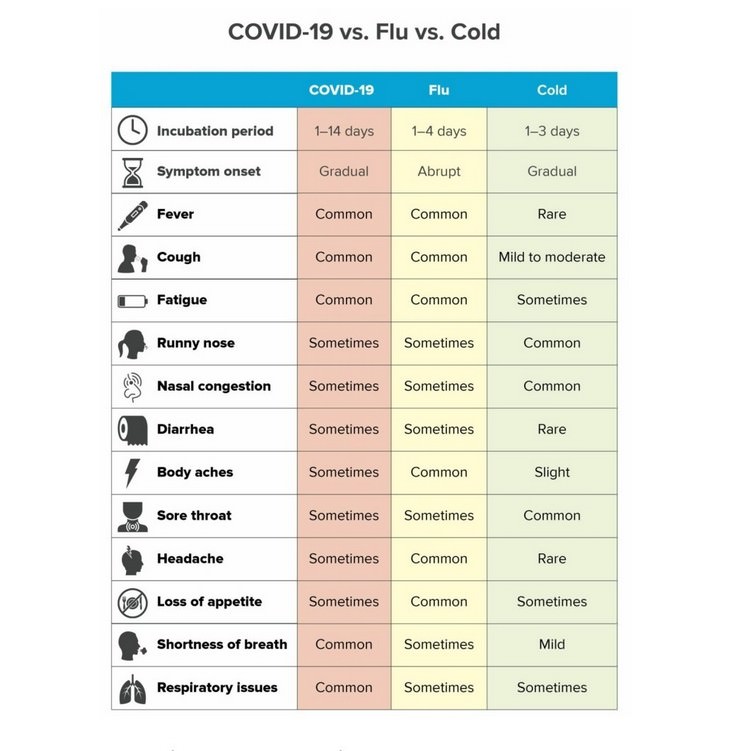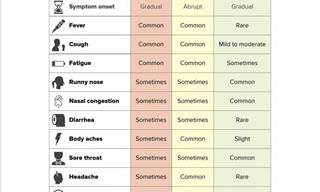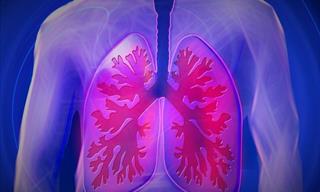As infection rates of the coronavirus continue to surge and lockdowns are gradually implemented pretty much everywhere around the world, it is important to be vigilant and aware of the virus symptoms. The tricky part is that Covid-19 shares quite a few symptoms with the flu and the common cold, which are both very likely to spread at this time of the year as well. But there are still some minor yet important differences, which are worth knowing and paying attention to.
Both Covid-19 and the influenza are transmitted the same way, through respiratory droplets, and they can both be transmitted by a carrier before they show any symptoms. There are several overlapping symptoms like fever, tiredness and a dry throat. The body’s normal temperature usually shifts between 36-37°C / 98°F. Any body temperature that is above 38°C/ 100.4°F is classified as a fever!
So How Are They Different?
There are a few symptoms that are typical to the flu but rarely occur in cases of Covid-19, like muscle pain and headache. The incubation period for the flu is shorter, thus symptoms appear sooner. This table outlines in detail the slight differences in symptoms:

Level of Contagiousness: Covid-19 is found to be more contagious than the flu. To work out how fast a disease is likely to spread, epidemiologists use a measure called ‘basic reproduction number’, also known as the R naught or R0. The R0 for Covid-19 is 2.5 - meaning any sick person is likely to infect 2 or 2.5 other people. The R0 for the flu, on the other hand, is just 1.3, which makes the new coronavirus almost twice as contagious.
Related Article: Can This Old Medical Approach Help Fight the Coronavirus?
Mortality Rate: For both diseases, the severity of symptoms can vary between mild to severe. However, the fraction of people who develop severe symptoms that require intensive care is higher for Covid-19, and the mortality rate is higher as well. For the seasonal flu, it tends to be 0.1 percent, which means one in 1000 people dies of the disease.
At the moment, 14% of all closed Covid-19 cases have resulted in death. But it is important to note that the true and precise mortality rate will take some more time to fully understand and determine.
The Group Most Affected: Another major difference is the population most susceptible to infection. While children and pregnant women tend to become very sick with the flu, they don’t seem to be significantly affected by Covid-19 to date. Those who are most at risk of being infected with Covid-19 and developing complications are older age groups and people with chronic illnesses and weakened immune systems. Data shows people in their 60s have the highest rate of diagnosis, but health authorities stressed that it does not mean young adults should not be complacent about the virus. The possibility of getting a severe form of the disease in younger patients does exist, and the preventative measures required by the WHO and CDC apply to everyone.

Treatment and prevention: As influenza has been around for much longer, a vaccination against it has been developed. Because the strains mutate, every year doctors try to predict which ones will be most common and select the right vaccine components for that season.
There are also antiviral drugs for the flu, which are sometimes prescribed to help the body reduce symptoms.
Unfortunately, there is still no vaccination or drugs against Covid-19, though health experts and scientists are working towards developing them, and some clinical trials are already underway.
The only measure we can take against Covid-19 at the moment is doing our best to prevent it. The way to do that is:
- Avoiding crowds and gatherings of any size
- Standing at least 6ft (2 meters) apart from other people
- Maintaining good hygiene - washing hands frequently
- Avoiding touching the face
- Staying at home as much as possible, especially if feeling unwell.
 Go to BabaMail
Go to BabaMail


























